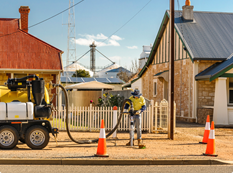Why and how water is treated
Why and how water is treated
The way we treat water depends on its source. South Australia has a range of sources, more than 80 different water supply systems and we draw from the best treatment methods, based on what’s needed to maintain the highest quality of drinking water to everyone in the state.
Treating your water before it gets to you is important to make sure it looks, smells and tastes right and meets health standards. And there are many ways we do it.
We select the most effective and most appropriate way to filter and treat your water depending on its source. And each method ensures we reach our high standards.
If you’d like to know how your tap water is disinfected, head to our handy search tool.
Chlorine
Chlorine is used in the water treatment process to protect public health and ensure water is safe to drink, destroying bacteria and other pathogens that can be present in source water.
Chloramine
Chloramine is used to safely disinfect water supplies across Australia and overseas. SA Health, through the Australian Drinking Water Guidelines, and the World Health Organisation both recognise that chloramine is safe and effective.
Like chlorine, chloramine destroys bacteria and other pathogens that can be present in source water and ensures your tap water is clean and safe to drink. Because chloramine is better than chlorine at penetrating longer pipes it’s used in our longer water distribution systems across the state.
Chloraminated water is also a better tasting tap water. It regularly performs well in the annual best tasting South Australian tap water program, and is a favourite during our own blind taste tests. In a blind controlled study of drinking water from the Myponga Reservoir, people preferred the taste of chloraminated water, compared to chlorinated water, which can have a distinct taste and smell.
Like all drinking water, chloraminated tap water must be neutralised before it is used in fish tanks, aquariums and ponds to protect your fish or other living aquatic creatures. This can be done using a product such as a water conditioner or a carbon filter. If you’re not sure, or you’d like specific advice on the most appropriate product for your situation, please contact your local pet shop or aquarium retailer.
While very small amounts of ammonia can sometimes be present naturally in fish tanks, the higher levels of ammonia through the use of chloramine to disinfect drinking water can be harmful to fish and aquatic amphibians, even at low levels.
Learn more about chloramine and its role in drinking water disinfection in South Australia.
Desalination
Our desalination plants use a technology called reverse osmosis which removes up to 99 per cent of the impurities and salt in the water. Once the impurities are removed, the water is treated to meet the Australian Drinking Water Guidelines, ensuring it is safe and ready to drink.
Saline concentrate is one of the by-products of the desalination process and at the Adelaide Desalination Plant at Lonsdale, this concentrate is put back into the ocean using a series of special diffusers. These sit about one kilometre off-shore and rapidly mix the concentrate with seawater to dilute it.
Fluoride
Fluoride is a trace mineral found naturally in water, soils and foods. It is added to South Australia’s metropolitan and major country drinking water supplies, as mandated by our state health authority, because it's proven to provide a significant public health benefit. Fluoride does not affect taste, look or the smell of your drinking water.
For more information on fluoride in water, visit the SA Health website.
Other treatment options
Membrane filtration
We have strategically invested in membrane filtration plants, which represent the future of water treatment. This process passes water through smaller pore sizes on the membranes, which produce a better outcome. These provide more of a physical barrier against some pathogens, reducing the risk even further to the wider public.
Iron removal (IRP)
Many South Australian groundwater sources contain higher iron concentrations and other chemicals. The iron removal process removes these naturally-occurring elements from the water, and while the presence of iron in water does not pose any health risk and the water is safe to drink, higher amounts can sometimes discolour drinking water and change its taste.
We are continually upgrading our iron removal plants to capture and reprocess backwash water. This reduces the amount of groundwater extracted and minimises environmental impact.
Magnetic ion exchange (MIEX)
Our Mount Pleasant and Middle River Water Filtration Plants were the first plants in the world to use Magnetic Ion Exchange (MIEX®) to treat the water.
This process – developed after years of research and teamwork by SA Water, industry leaders like Orica and research leaders like the CSIRO, removes the main cause of colour in the water: dissolved organic carbon. MIEX improves the taste and smell of drinking water, and also reduces the levels of chlorine needed.
Ultraviolet light (UV)
Ultraviolet light is used in some of our plants – exposure to appropriate doses of UV light destroys bacteria, viruses and protozoa, making them non harmful to humans. The required UV dose is dependent on certain water quality factors such as clarity, dissolved compounds and microorganisms present.
Major faults
Polkinghorns Rd
Arthurton
- 18/06/2020
Water Supply On
- 18/06/2020 03:05 PM - We are attending to an incident in Arthurton with no interruption to the water supply. The safety of our crews and customers comes first, and we always aim to minimise inconvenience by restoring services as quickly as we can. Reference Number WO: 07505663.
- See all major faults
Scheduled works
Spruance Rd
Elizabeth East
- 11/06/2021
Temporary Supply Interruption
- Estimated start time and water supply off: 15/06/2021 09:00 AM
Estimated restore time and water supply back on: 15/06/2021 04:00 PM
We’re improving your services and undertaking maintenance work in Elizabeth East. Sometimes our crews need to temporarily interrupt the water supply to our customers and/or manage traffic while they are working. Temporary traffic management may remain in place until reinstatement of the impacted road is complete. We always aim to minimise inconvenience by restoring services as safely and quickly as we can. - See all scheduled works









